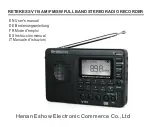
OSPF metric 2: Metric of OSPF type 2. If the rule does not have a metric value filled in, the static
Metric value is used.
OSPF metric sum: Sum of OSPF type 1 a type 2 metrics. If the rule does not have both metric
values filled in, the static Metric value is used.
Metric
Number {0 – 65534}, default = 0
Routing rule metric value. The higher the value, the more “expensive” the path is.
Note
Informational note.
7.2.3. OSPF
Open Shortest Path First (OSPF) is a routing protocol for Internet Protocol (IP) networks. It uses a link
state routing (LSR) algorithm and falls into the group of interior gateway protocols (IGPs), operating
within a single autonomous system (AS). OSPF Version 2 defined in RFC 2328 (1998) for IPv4 is im-
plemented in the RipEX router. OSPF provides Layer 2 dynamic routing. In the context of RipEX networks
it is typically used for the backhaul network routing.
7.2.3.1. Description
OSPF splits the network into “areas” to simplify the network topology. There is a primary “backbone”
(0.0.0.0) area and the other areas are connected to this backbone area via border routers.
The route decision process is affected by the path “metric”. There are two types of metrics:
• Metric Type 1 – path length; individual interfaces pass-over costs are added.
• Metric Type 2 – is setup on the rules which are exported to the OSPF from outside. Rules having
metric ‘Type 2’ are always treated as worse (i.e. longer path) comparing to metric ‘Type 1’.
Routers in a specific area are always connected via interfaces.
• An address range can be defined for an interface where is the OSPF working. Multiple address
ranges can be defined (behaving as another interface).
• Router to router interconnection can be protected by encryption with the password.
• Specific “Cost” is defined for each interface which is added to metric ‘Type 1.’
• There are multiple types of interfaces:
○ Stub – interface only announces to OSPF: its presence and its address ranges to be propagated
further to the network.
○ Broadcast – to be used in the network where all the participants always hear each other (Ethernet).
Designated Router (DR) and Backup DR (BDR) are setup between the neighbors. They are re-
sponsible for the update propagation (broadcast).
○ NBMA (Non-Broadcast Multiple Access) – to be used in the network where only specific participants
can communicate between each other; all the participants hear each other but multicast is not
available. DR and BDR is setup.
109
© RACOM s.r.o. – RipEX2 Radio modem & Router
Settings
















































